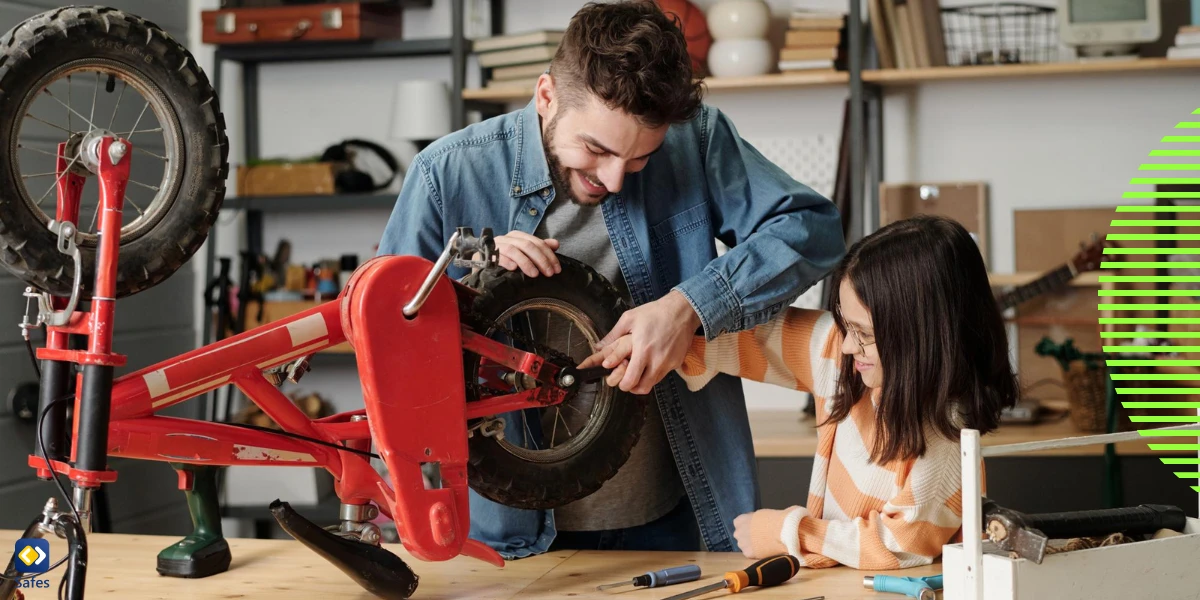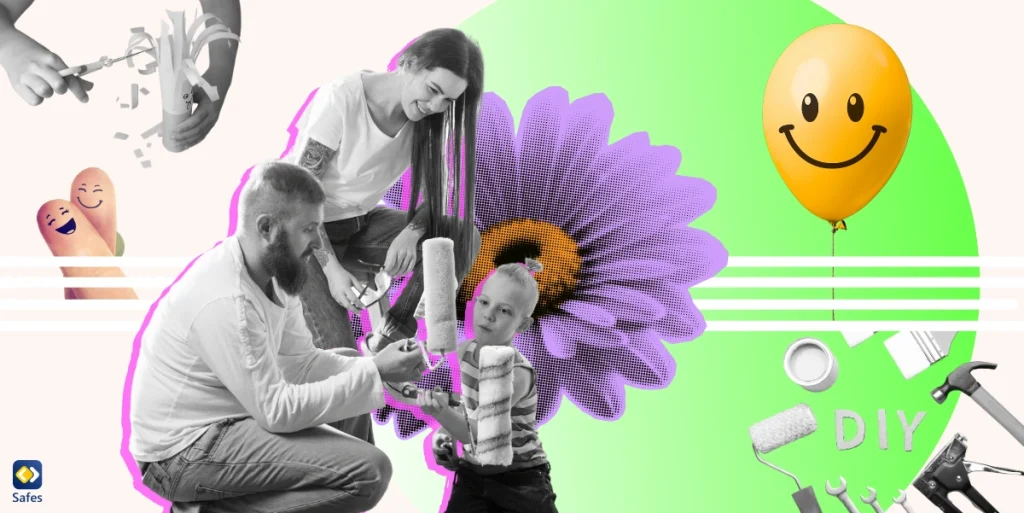With the ever-increasing immersion of children into the virtual world, it’s more important than ever to provide real-life activities that foster creativity, imagination, and hands-on learning. DIY (Do It Yourself) activities are a fantastic way to achieve this. Not only do they provide fun for the young ones, but they also help them develop essential skills and bond with their parents or siblings. Thankfully, there are DIY activities for every age group, so whether you have a toddler, a young child, a preteen, or a teenager, there’s always something for them.
Download and Start Your Free Trial of the Safes Parental Control App
Today’s article will explore DIY projects for kids of all ages at home, from toddlers to teenagers. We’ll cover everything from simple crafts to more complex projects that the whole family can enjoy. So, let’s discover the wonderful world of DIY activities that will keep your child entertained and engaged.
DIY Activities for Toddlers (Ages 2-4)
Toddlers are full of energy and curiosity and love exploring the world around them. Engaging them in age-appropriate DIY activities is a great way to channel their energy and stimulate their growing minds. Here are some DIY activities that are perfect for toddlers:
Sensory Bins
Sensory bins are a fantastic way to engage toddlers and stimulate their senses. Create a sensory bin by filling a container with materials such as rice, sand, or water beads. Add in objects like plastic animals, spoons, and cups for your toddler to explore. This activity not only provides a sensory experience but also encourages imaginative play and fine motor skills.
Homemade Playdough
Making homemade playdough is a fun and easy DIY activity that toddlers will love. Combine flour, salt, water, and food coloring to create a soft, moldable dough. Let your toddler help mix the ingredients and choose their favorite colors. Playing with playdough helps develop fine motor skills and encourages creativity.

Nature Walk and Leaf Collage
Take your toddler on a nature walk and collect leaves of different shapes and colors. Once you’re back home, create a leaf collage by gluing the leaves onto a piece of paper or cardboard. This activity allows toddlers to connect with nature, practice their fine motor skills, and learn about different types of leaves.
While scavenging, you can try apps like Seek by iNaturalist to learn about different plant species. More information at: From Screen Time to Green Time: A Parental Review of Seek by iNaturalist
DIY Activities for Young Kids (Ages 5-8)
As children grow older, their interests and abilities expand. Young kids aged 5-8 are ready to tackle more complex DIY activities that challenge their creativity and problem-solving skills. Here are some ideas:
DIY Birdhouse
Building a birdhouse is a fantastic DIY project for young kids. Provide them with pre-cut wooden pieces, nails, and a hammer (under adult supervision) to assemble their own birdhouse. They can then paint it with vibrant colors to attract birds to their creation. This activity teaches woodworking skills, patience, and the importance of caring for nature.
Tie-Dye T-Shirts
Tie-dyeing t-shirts is a classic DIY activity that never goes out of style. Set up a tie-dye station with plain white t-shirts, rubber bands, and fabric dyes. Let your kids create unique designs by twisting and tying the shirts before applying the dyes. After the shirts have dried, they’ll have personalized masterpieces to wear proudly. This activity promotes creativity and allows kids to experiment with color mixing.

DIY Science Experiments
Young kids have a natural curiosity about the world around them. Engage their scientific minds with simple DIY science experiments. For example, create a volcano by combining baking soda and vinegar, or make a homemade lava lamp using oil, water, and food coloring. These experiments introduce basic scientific concepts and encourage critical thinking.
DIY Activities for Preteens (Ages 9-12)
Preteens are at an age where they’re eager to explore their interests and develop new skills. DIY activities that challenge their creativity, problem-solving abilities, and independence are ideal for this age group. Here are some ideas:
DIY Jewelry Making
Jewelry making is a popular DIY activity for preteens. Provide them with a variety of beads, strings, and clasps to create their own unique bracelets, necklaces, or earrings. They can experiment with different colors, patterns, and designs and even gift their creations to friends or family. This activity encourages creativity, fine motor skills, and attention to detail.
Upcycled Crafts
Encourage preteens to be environmentally conscious by engaging them in upcycling projects. Provide them with materials such as old magazines, cardboard boxes, and fabric scraps, and challenge them to transform these items into something new and useful. They can create magazine collages, cardboard sculptures, or fabric accessories. This activity promotes creativity, resourcefulness, and a sense of sustainability.

DIY Stop Motion Animation
Preteens are often fascinated by the world of animation. Introduce them to the art of stop-motion animation by providing them with a smartphone or tablet, a tripod, and a simple animation app. They can create their own stories by moving objects or characters frame by frame and bringing them to life with the app. This activity develops storytelling skills, patience, and attention to detail.
DIY Activities for Teens (Ages 13-17)
Teenagers have more advanced skills and interests, and they often seek DIY activities that allow them to express themselves and explore their passions. Here are some DIY activities that are perfect for teens:
DIY Photography Projects
Teens interested in photography can embark on various DIY projects to enhance their skills. They can experiment with different lighting techniques, create their own photo backdrops, or even build a homemade pinhole camera. This activity encourages creativity, technical skills, and a unique perspective on the world.
DIY Home Decor
Teens can personalize their living spaces by engaging in DIY home decor projects. They can paint their bedroom walls with bold colors, create custom wall art using canvas and acrylic paints, or repurpose old furniture with a fresh coat of paint. This activity allows teens to express their individuality, develop design skills, and take pride in their surroundings.

DIY Coding Projects
For tech-savvy teens, DIY coding projects provide an opportunity to explore the world of programming. They can learn programming languages like Python or JavaScript and create their own websites, games, or apps. This activity fosters problem-solving skills and logical thinking and opens up future career possibilities in the tech industry.
- Related Article: Best Kids Coding Apps to Set Your Child on the Programming Path
DIY Projects for the Whole Family
DIY activities aren’t just for kids; they’re a fantastic way to bond as a family and create lasting memories. Here are some DIY projects that everyone in the family can enjoy:
Family Recipe Book
Gather your family’s favorite recipes and create a DIY recipe book. Let each family member contribute their own recipes, along with personal stories or memories associated with the dishes. Design and decorate the book together, and it will become a cherished family heirloom. This activity promotes teamwork, creativity, and culinary skills.
DIY Garden
Create a DIY garden in your backyard or even on a windowsill. Let each family member choose their favorite plants or vegetables to cultivate. Involve everyone in planting, watering, and caring for the garden. This activity teaches responsibility and patience and provides an opportunity to connect with nature.

DIY Movie Night
Transform your living room into a cozy movie theater with a DIY movie night. Create homemade popcorn, set up blankets and pillows, and choose a family-favorite movie to watch together. You can even make your own movie tickets and popcorn containers. This activity brings the family together for quality time and shared laughter.
We have quite a few articles on Safes about movies; make sure you check them out:
- 10 Spooky Horror Movies Perfect For 10-Year-Olds
- 11 Must-Watch Inspirational Movies for Kids
- Movie Night: 8 Funny Movies to Watch with Your Teenagers
- Discover the Magic of Movies About Child Development with Your Kid!
- The Best Documentaries to Watch with Your Middle Schooler
- 7 Documentaries You Can Watch with Your Teenager
- 15 Amazing Family Documentaries to Watch with your kid
Safety Tips for DIY Activities with Children
While DIY activities are fun and beneficial, it’s essential to prioritize safety. Here are some safety tips to keep in mind when engaging in DIY activities with children:
- Always provide adult supervision, especially when using tools or materials that may pose a risk.
- Choose age-appropriate activities and materials that are safe for children.
- Ensure the workspace is clean and organized to minimize accidents.
- Teach children how to properly handle and use tools and materials.
- Use child-friendly alternatives for potentially hazardous materials.
- Teach children the importance of following instructions and safety guidelines.
Benefits of DIY Activities for Child Development
Engaging in DIY activities offers numerous benefits for a child’s development. Here are some key advantages:
Creativity and Imagination: DIY activities encourage children to think creatively and use their imaginations to solve problems and create unique projects.
Fine Motor Skills: Many DIY activities involve cutting, gluing, painting, and manipulating materials, which helps develop fine motor skills and hand-eye coordination.
Problem-Solving: DIY activities often require children to think critically and find solutions to challenges they may encounter during the project.
Independence and Confidence: Completing DIY projects gives children a sense of accomplishment and boosts their self-esteem as they see their ideas come to life.
Bonding and Communication: Engaging in DIY activities as a family or with friends promotes bonding, communication, and teamwork skills.
Learning Opportunities: DIY activities provide opportunities for children to learn about various subjects, such as science, nature, art, or technology.
Incorporating DIY Projects into Daily Life
DIY projects don’t have to be limited to specific occasions or free time. Research shows that hands-on experience is more critical for young children rather than just educational activities. So, you should incorporate DIY activities into your daily life to enrich your child’s experiences. Here are some ideas:
DIY Chore Charts: Create a DIY chore chart to involve your child in household responsibilities. Let them decorate it and take ownership of their tasks.
DIY Meal Planning: Involve your child in meal planning and preparation. Let them choose recipes, write grocery lists, and assist with cooking. This encourages healthy eating habits and life skills.
DIY Home Repairs: Teach your child basic DIY home repair skills, such as changing a light bulb, fixing a leaky faucet, or painting a room. This promotes independence and practical knowledge.

Incorporating DIY projects into your daily life creates opportunities for learning, creativity, and shared experiences.
Fun Things to Make with Kids: Conclusion
DIY activities are a wonderful way to engage children of all ages in fun and educational projects. In this guide, we introduced various DIY activities for children of all ages. They evolve painting, cutting and pasting, gardening, cooking, science, you name it! With these activities, there is fun and education for the entire family and not just the children since you can team with your little ones to create something amazing.
Some DIY activities evolve using technology and the Internet. It’s necessary to have your child’s safety in mind when allowing them to use their digital gadgets such as phones, tablets, and computers. When using these tools, children are potentially exposed to various cyber risks, including scamming, age-inappropriate content, cyberbullying, and even excessive screen time. One tool that can help you manage your child’s access to their devices and the Internet is the Safes parental control app.
You can download Safes from App Store and Google Play to start your free trial. Learn how to put parental controls on different platforms using Safes with the links below:
- Windows parental controls
- Macbook parental controls
- Parental controls on Android
- iPhone parental controls
Your Child’s Online Safety Starts Here
Every parent today needs a solution to manage screen time and keep their child safe online.
Without the right tools, digital risks and excessive screen time can impact children's well-being. Safes helps parents set healthy boundaries, monitor activity, and protect kids from online dangers—all with an easy-to-use app.
Take control of your child’s digital world. Learn more about Safes or download the app to start your free trial today!




